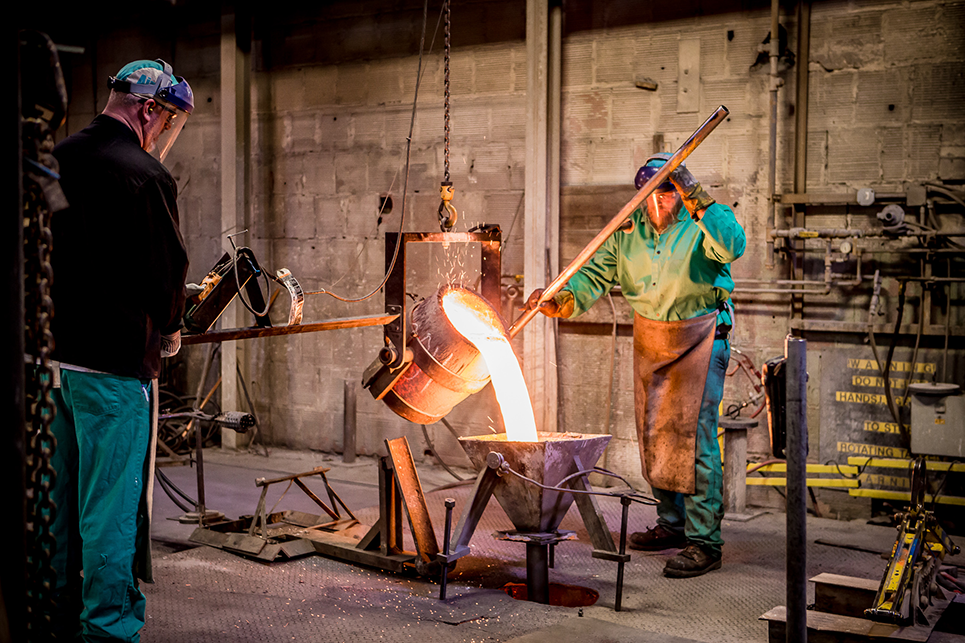Why Copper Quality Matters in High-Voltage Applications


When customers talk about copper quality, the word can mean many things: purity, strength, conductivity, surface finish, or even consistency from batch to batch. Quality is often described as not a single property but “a special relationship between the supplier and the user”, one that is built on technical understanding, trust, and communication. Mendenhall, J. Howard. Understanding Copper Alloys: The Manufacture and Use of Copper and Copper Alloy Sheet and Strip. Wiley, 1980
At the Electric Materials company, that relationship defines our approach. For us, copper quality is not just what’s inside the metal. It is how we engineer, manufacture, and deliver the product. From melt to finished part, every step is under our roof and under our control. That’s what truly sets us apart in the copper industry.
From Melt to Finish: Total Control, Total Confidence
Electric Materials (EM) is a vertically integrated manufacturer, meaning that we control every stage of the production process – from melting and casting to rolling, machining, plating, and finishing.
Many competitors outsource some or all of these stages, especially finishing steps such as plating or machining. Each handoff increases variability, adds logistics risks, and reduces accountability. We keep it all in-house to ensure:
- Consistent metallurgy and uniform mechanical properties.
- Precise dimensional control through every forming and machining operation.
- Surface integrity and finish quality suitable for electrical performance and assembly.
- Traceability back to the original melt, alloy batch, and process parameters.
That level of integration means that customers can count on predictable performance, technical support and reliable delivery, no matter how demanding the application.
Engineering Collaboration: Quality Defined by Use
True quality, as Mendenhall emphasized, is a shared understanding between the user and the supplier. The customer knows the functional and fabrication requirements, the manufacturer understands the material properties and production methods that achieve those needs best.
That collaboration is built into how we work at EM. Our engineers, metallurgists, and production teams partner with customers early in the design process to:
- Select the most suitable alloy for electrical, mechanical, and cost targets.
- Adjust designs for manufacturability or improved performance.
- Recommend modifications that reduce cost without sacrificing quality.
- Provide prototypes, testing, and rapid iteration for custom components.
This open exchange allows our customers to achieve the right quality at the right cost, not over-specifying materials that add unnecessary expense.
The Right Alloy for Every Application
Every alloy selection aligns with the functional needs of each application, and the job of our metallurgical experts is to ensure this alignment. They understand how each alloy behaves in forming, joining, plating, and finishing operations, and our manufacturing process is tailored accordingly to optimize the performance. Here are some of the standard EM alloy grades and their attributes:
| UNS Alloy | Pros | Cons | Typical Uses |
| C10100 & C10200 | Very high purity (99.99% / 99.95%); excellent conductivity (100%+ IACS); oxygen-free for weld/braze reliability | More costly due to specialized casting equipment for oxygen-free alloys; lower machinability | Bus bars, copper forgings, switchgear, rotor bars and end rings for AC motors |
| C11000 | High purity (99.9%), 100%+ IACS conductivity | Susceptible to hydrogen embrittlement in reducing atmospheres during joining/annealing processes | Bus bars, switchgear, electrical components |
| C11300, C11400, C11600 | High purity (99.90%). Very high conductivity (100%+). Small silver additions increase resistance to softening at high temperatures | Same hydrogen embrittlement risk as C11000 | Bus Bar, commutator bar segments for DC motors, rotor coils for large generators |
| C12**00 | High conductivity (85%). De-oxidized with phosphorus. Oxygen-free, good weldability with no precautions against hydrogen embrittlement. Lower cost vs. C10100/C10200 |
Reduced conductivity (~85%) vs. C10100/C10200 |
Heat exchangers, plating anodes |
| C14700 | High conductivity (90%+), with sulfur & phosphorus addition. Excellent machinability | Less weldable and susceptible to hydrogen embrittlement due to sulfur content | Connectors, fasteners, terminal connectors |
Compliance, Responsibility, and Trust
Quality extends beyond the metallurgical and mechanical. Customers today demand confidence in where and how their materials are made. Electric Materials conducts full due diligence and documentation for every order, ensuring the product meets demanding performance, environmental and ethical standards including:
- Conflict minerals compliance
- REACH and RoHS conformity
- Country of origin and material traceability
These standards are not optional extras – they are part of doing business responsibly. Competing products that appear “cheaper” often lack this level of certification or supply-chain integrity, exposing users to risk.
Beyond Price: The True Meaning of Value
In copper manufacturing, a lower price rarely means a lower total cost. Outsourced or uncertified materials may save dollars upfront but often cost more over time – in rework, downtime, or compliance issues. At EM, value is measured in reliability, consistency, and long-term trust. By keeping production fully in-house and maintaining rigorous process control, our experts know that performance and predictability is what our customers depend on. We believe that the product quality is not defined by a number on a specification sheet. It’s defined by the people, processes, expertise and partnership behind it. True copper quality comes from doing everything – from the melt to the final finish – with precision, transparency, and collaboration. That’s what allows us to deliver not just copper components, but confidence in performance.

